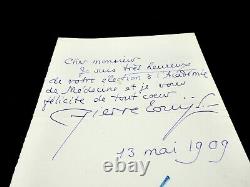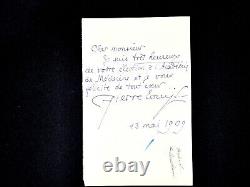
- Homepage
- Author
- Anatole France (3)
- Beydts (louis) (4)
- Camille Mauclair (3)
- Charles Monselet (3)
- Chateaubriand (5)
- Colette (3)
- Ernest Daudet (3)
- Eugène Labiche (3)
- Jean Couty (3)
- Jean-léon Gérôme (5)
- Julien DuprÉ (3)
- Louise Read (4)
- Marcel Proust (5)
- Paul Chabas (4)
- Paul Meurice (3)
- Proust (3)
- Roger Martin Du Gard (4)
- Salomon Reinach (3)
- Sully Prudhomme (7)
- Violette Leduc (4)
- Other (3890)
- Binding
- Era
- 18th Century (9)
- 1900 To 1960 (55)
- 1960s (4)
- 1970s (7)
- 19th (5)
- 19th Century (45)
- 20th Century (11)
- Beautiful Era (12)
- Belle Epoque (46)
- First Empire (7)
- First World War (4)
- Nineteenth (17)
- Nineteenth Century (7)
- Post-war (21)
- Restoration (15)
- Revolution (4)
- Roaring Twenties (27)
- Second Empire (19)
- Second World War (5)
- World War Ii (9)
- Other (3636)
- Language
- Region
- Theme
Pierre Louÿs Beautiful autograph on a signed handwritten letter Academy 1909











Autographed letter signed by Pierre Louÿs to Maurice De Fleury: Congratulations on your election to the Academy of Medicine - May 13, 1909. A close friend of André Gide and Paul Valéry, he contributed to the Symbolist movement and became known for his collections of poems "The Songs of Bilitis" and his novel "Aphrodite". His work often explores themes of love and sensuality with great literary finesse.
A student of Charcot and director of the laboratory of physiological psychology at the Salpêtrière, he maintained close relationships with many literary figures, including Émile Zola. His works left a mark on literature and science of his time, and he was elected a free associate of the Academy of Medicine in 1909. In 1909, Maurice de Fleury was elected a free associate of the Academy of Medicine, an important recognition of his contributions to medicine and psychiatry. Pierre Louÿs, as a friend and admirer of De Fleury, sent him a letter of congratulations. "I am very happy about your election to the Academy of Medicine and I congratulate you wholeheartedly.
Condition: Good overall condition - clear and readable handwriting with a beautiful signature. Erasures on the front, stains on the back, and a very small tear that does not hinder reading.
A student of Charcot, De Fleury began his career as an intern at Sainte-Périne Hospital. At the Salpêtrière, he led the laboratory of physiological psychology, establishing himself as a central figure in Parisian psychiatry. Close to literary circles, Maurice de Fleury had close relationships with Émile Zola and Joris-Karl Huysmans. A fervent admirer of the Rougon-Macquart, he provided Zola with his scientific knowledge on heredity, a crucial theme in Zola's work.His publications on the transmission of nervous diseases, violence, and alcoholism deeply influenced Zola's work, including "Doctor Pascal". Ten years after their collaboration, De Fleury drew a medico-psychological portrait of Zola. From ten o'clock to noon, Zola still writes - less easily and less well than during the initial hour - and that's it for the day, he will only be good for writing letters. That is the power of the most powerful brain in the literary field at the end of the century. With this very small modest routine, three hours a day in two sessions, this man whose attention is modest...
Manages to give us, every ten months, one of those books where nothing is lacking, neither the solidity of the structure... Nor anything that constitutes creative force, genius, to say the word. He also maintained a lively correspondence with famous friends and patients from the artistic, literary, and political circles of the time: Alphonse Daudet, Alexandre Dumas (son), Sarah Bernhardt, La Bartet, Madame Simone, Sacha Guitry, Edouard Herriot, Raymond Poincaré, Jean Rostand, Victorien Sardou, Robert De Flers, Réjane, Marie Bonaparte. Very "in vogue" among "intellectuals" (in the words of Victor Segalen), the young doctor also appears on the list of Symbolist authors - alongside Paul Adam, Henri de Régnier, and Gustave Kahn - in an essay by André Barre in 1911. Recognized for his literary talents as much as his scientific ones, he published significant works on depressive states and neurasthenia.
Elected a free associate of the Academy of Medicine in 1909, he was raised to the rank of Commander of the Legion of Honor in 1923. He is famous for his numerous supporting roles in cinema, especially in films like "Le Viager" and "Les Gaspards".

